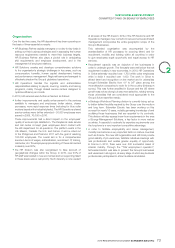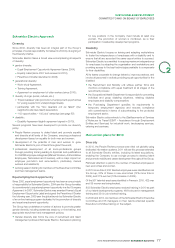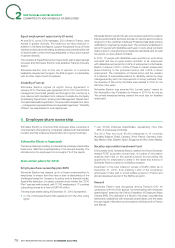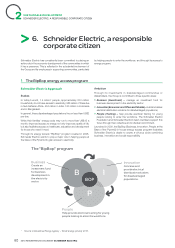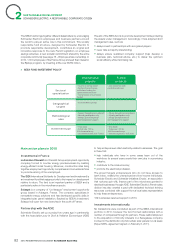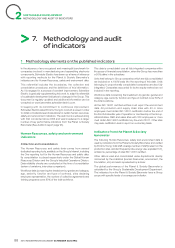APC 2010 Annual Report Download - page 83
Download and view the complete annual report
Please find page 83 of the 2010 APC annual report below. You can navigate through the pages in the report by either clicking on the pages listed below, or by using the keyword search tool below to find specific information within the annual report.
SUSTAINABLE DEVELOPMENT
SCHNEIDER ELECTRIC, ARESPONSIBLE CORPORATECITIZEN
>WHO IS A PERSON AT THE BASE OF THE PYRAMID?
“Base of the pyramid” is a term widely used today to
refer to those with the lowest income either in the world
or in a given country. Whether seen in absolute terms
(income of less than US$1.25 per day in “purchasing
power parity” terms according to the World Bank) or in
relative terms (income of less than 60% of the average
income for the European Union), poverty affects people
in marginalised situations (infrastructure, isolation, poor
access to banking structures, etc.). Specifi c approaches
are required to meet these challenges and to contribute
to reducing poverty.
Organisation
Management
The program is managed by the Sustainable Development Offi ce.
The BipBop program management team has been strengthened
in 2010 in line with the ambitious objectives set for it in the One
program. The team is now spread equally between France and India:
•a BipBop solutions Business Development Director;
•an Offer Creation Director based in Bangalore (India);
•a Welfare Investment Director, who manages the Schneider
Electric Energy Access social welfare fund;
•a Training Programs Director;
•a Coordinator who leads stakeholders both within and outside
the program.
The team is actively supported by Schneider Electric’s staff in the
fi eld.
Deployment
BipBop operates through its local presence in the countries
concerned by the energy access problem to achieve its goals. With
a few rare exceptions, all projects initiated benefi t from monitoring
by employees of Schneider Electric entities operating in the country.
These employees constitute a network of key contact people for the
design, management and monitoring of projects.
Their involvement may be part- or full-time. They contribute their
knowledge of the local context (organisation of civil society, local
authorities, the private sector) and guarantee that the project is
aligned with local needs. Their presence is of crucial importance
for the long-term oversight of projects in which Schneider Electric
is involved.
The main areas targeted by BipBop are India, China, South Asia,
Sub-Saharan Africa and South America.
Two high-priority social performance community-oriented objectives were established in the Planet & Society Barometer for the duration of
the One program (2009-2011):
Objectives for Year-End-2011 2010 2009 2008
1. 10,000 young people at the Base of the Pyramid trained in the energy management professions 4,742 2,150 0
2. 500 new entrepreneurs at the Base of the Pyramid set up their activities in the energy
management fi eld 209 125 0
The 2008 performance serves as a starting value for the Planet & Society Barometer within th One Program between 2009 and 2011.
A third indicator of the Planet & Society barometer is monitored in the BipBop program: “1,000,000 households at the Base of the Pyramid
have access to energy thanks to Schneider Electric solutions”. However, this indicator, although having a certain societal impact, follows
a market approach, unlike the two other BipBop indicators, which have a philanthropic purpose. It is therefore presented in the chapter
regarding economic performance on page 54.
Please refer to pages 88 to 90 for the methodological presentation of indicators, and the following pages for the analysis of the results
(pages 83 for indicator 1 and 87 for indicator 2).
Sustainable investment (Business)
In July2009, Schneider Electric announced the creation of a global
sustainable venture capital fund called Schneider Electric Energy
Access (SEEA), with an initial capital of EUR3 million.
As of December31, 2010, the following amounts were managed
by the fund:
•EUR3,000,000 in capital invested by Schneider Electric;
•EUR500,000 in capital invested by Schneider Energie Sicav
Solidaire, a sustainable mutual fund.
Schneider Energie Sicav Solidaire encompasses SEISAS, la Caisse
des Dépôts et Consignations and the Schneider Energie corporate
mutual fund. 1,500 Group employees evinced an interest in the
BipBop project by investing a little in excess of EUR2million.
Approach
Created with the support of the Crédit Coopératif, the fund’s mission
is to support the development of entrepreneurial initiatives worldwide
that will help the poorest among us obtain access to energy. It will
invest in specifi c projects:
•help jobless individuals create businesses in electricity;
•promote the development of businesses that provide access to
energy in rural or suburban areas in developing countries;
•support the deployment of innovative energy access solutions
that use renewable energies for people at the Base of the
Pyramid.
2010 REGISTRATION DOCUMENT SCHNEIDER ELECTRIC 81
2




